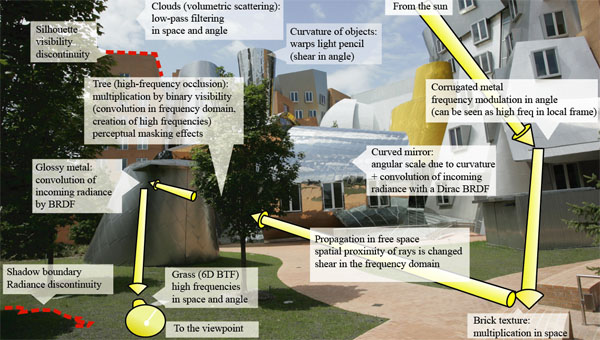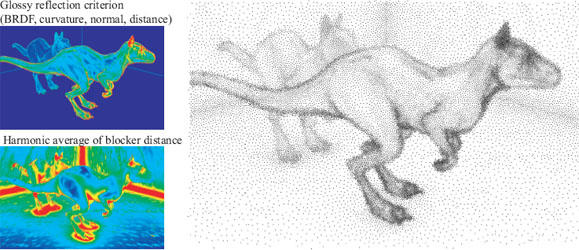A Frequency Analysis of Light Transport
Frédo Durand, Nicolas Holzschuch, Cyril Soler, Eric Chan & François Sillion
Goals
Capturing and reproducing the richness of our visual world is a central goal of computer graphics. While image processing has had a large impact on antialiasing and local shading, and despite the importance of Fourier analysis in optics, there has been little work in computer graphics on frequency analysis of global lighting. Filling this gap would be a significant step, especially given the importance of sampling the space of rays for rendering and material acquisition.

Introduction
Light in a scene is transported, occluded, and filtered by its complex interaction with objects. By the time it reaches our eyes, radiance is an intricate function, and simulating or analyzing it is challenging.
Frequency analysis of the radiance function is particularly interesting for many applications, including forward and inverse rendering. The effect of local interactions on the frequency content of radiance has previously been described in a limited context. For instance, it is well-known that diffuse reflection creates smooth (low-frequency) light distributions, while occlusion and hard shadows create discontinuities and high frequencies. However, a full characterization of global light transport in terms of signal processing and frequency analysis presents two major challenges: the domain of light rays is intricate (three dimensions for position and two for direction), and light paths can exhibit an infinite number of bounces (i.e. in terms of signal processing, the system has dense feedback).
To address the above challenges, we focus on the neighborhood of light paths. This restriction to local properties is both a price to pay and a fundamental difficulty with the problem we study: characteristics such as reflectance or presence and size of blockers are non-stationary: they vary across the scene.
Contributions
We present a signal-processing framework for light transport. We study the frequency content of radiance and how it is affected by phenomena such as shading, occlusion, and travel in free space. This extends previous work that considered either spatial or angular dimensions, and offers a comprehensive treatment of both space and angle.
We characterize how the radiance signal is modified as light propagates and interacts with objects. In particular, we show that occlusion (a multiplication in the primal space) amounts in the Fourier domain to a convolution by the frequency content of the blocker. Propagation in free space corresponds to a shear in the space-angle frequency domain, while reflection on curved objects performs a different shear along the angular frequency axis. As described by previous work, reflection is a convolution in the primal space, and therefore amounts to a multiplication in the Fourier domain. Our extension shows how the spatial components of lighting are affected by this angular convolution.
We show that our signal-processing framework predicts the characteristics of interactions such as caustics, and the disappearance of the shadows of small features. Predictions on the frequency spectrum of the radiance function can then be used to control sampling rates or the choice of reconstruction kernels for rendering. Other potential applications include pre-computed radiance transfer and inverse rendering.

Space-angle frequency spectra of the 4D radiance function measured in
a 3D scene. We focus on the neighborhood of a ray path and measure the
spectrum of a 4D light field at different steps, which we summarize as
2D plots that include only the radial components of the spatial and angular
dimensions . Notice how the blockers result in higher spatial frequency,
and how transport in free space transfers these spatial frequencies to
the angular domain. Aliasing is present in the visualized spectra due
to the resolution challenge of manipulating 4D light fields.


Scene rendered with adaptive sampling rate based on our prediction of
frequency content. Only 20,000 shading samples were used to compute a
800x500 image (downsampled here for web viewing). The criteria and sampling
pattern are shown on the second image.
Research support
This work was supported by an NSF CAREER award 0447561 "Transient Signal Processing for Realistic Imagery," an NSF CISE Research Infrastructure Award (EIA9802220), an INRIA équipe associée and the MIT-France program.
This research was conducted in collaboration with the Artis team in Grenoble, France.
References
[1] Frédo Durand, Nicolas Holzschuch, Cyril Soler, Eric Chan & François Sillion. A Frequency Analysis of Light Transport. In Transactions on Graphics 24(3), 2005 (special issue for the Proceedings of SIGGRAPH 2005).
The Stata Center, Building 32 - 32 Vassar Street - Cambridge, MA 02139 - USA tel:+1-617-253-0073 - publications@csail.mit.edu (Note: On July 1, 2003, the AI Lab and LCS merged to form CSAIL.) |
